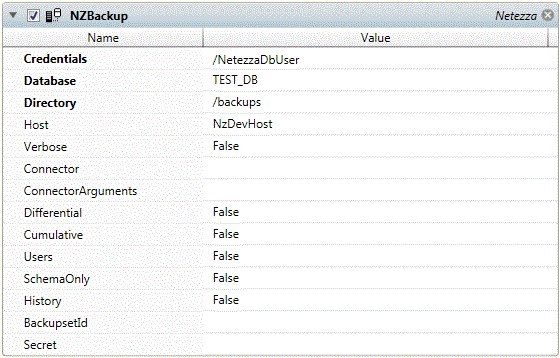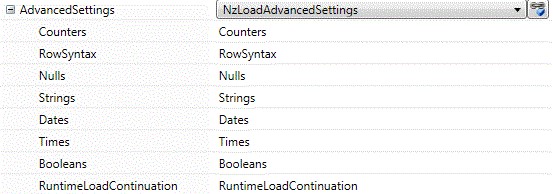Netezza
ActiveBatch supports several Netezza job steps. For the Windows platforms, the Netezza OLE/DB drivers are used; for non-Windows platforms, Java JDBC drivers are used.
ActiveBatch also supports installation of the ActiveBatch Execution Agent directly on the Netezza appliance. Doing this allows the Netezza Backup job step to be used (which means you cannot execute this job step unless you have installed the ActiveBatch Execution Agent).
For all Netezza job steps, you must install the Netezza OLE/DB driver software on the Job Scheduler system.
For the PL-SQL job step, you must install the Netezza OLE/DB driver software on the Job Scheduler system (as well as Windows-based Execution Agents) and JDBC drivers for the UNIX-based Execution Agents.
For the Load Data job step you must install the Netezza Admin Client software for both Windows and Non-Windows based Execution Agents.
This job step will backup data on the Netezza system including all schema objects and all table data within the database.

Job Step Properties
Credentials – This property is a User Account object that contains security credentials that will provide proper access to the Netezza system and database/table.
Database – This property is the target database you want to connect to.
Directory – This property represents the full path of the directory where the backup schema and data files are stored.
(Note: For disk backup and not Veritas (Symantec) or Tivoli).
Host – This property represents the location of the target Netezza system.
Verbose – This Boolean property indicates whether a verbose log of backup events should be performed. Default=False.
Connector – This property names the connector to which you are sending the backup. This dropdown would consist of selections like filesystem, Veritas (Symantec) or Tivoli.
ConnectorArguments – This property consists of pass through parameters sent to the connector (format:
name=value).
Differential – This Boolean property, if true, indicates that only that which changed since the last backup should be performed. Default=false.
Cumulative – This Boolean property if true indicates that which changed since the last full backup should be performed. Default=false.
Users – This Boolean property, if true, backs up users, groups and global permissions rather than a database. Default=false.
SchemaOnly – This Boolean property, if true, backs up only the schema and not the data. Default=false.
History – This Boolean property, if true, generates a backup history report.
BackupsetId – This property indicates the backup set you wish to use for an incremental backup.
Secret – This property specifies the secret backup key for an encrypted backup.
Return Step Value
This job step returns ExitCode, Output and Error variables.
Note: This job step requires that an ActiveBatch Execution Agent be deployed directly on the Netezza appliance. This is because, currently, the Backup utility is server and not client based.
This job step loads data into the Netezza appliance.

Netezza: Load Data – General
Job Step Properties
Host – This property represents the location of the target Netezza system.
Credentials – This property is a User Account object that contains security credentials that will provide proper access to the Netezza system and database/table.
Database – This property is the target database you want to connect to.
Table – This property is the target table within the database.
SecurityLevel – This property indicates the desired security level for the connection. The dropdown provides selections of secure or unsecure and whether the security setting is desired or mandatory.
CACertificateFile – This property is a security certificate appropriate when requesting secure access.
Files – This is a collection of files to load.

Netezza: Load Data – Files
Badfile – This property represents a file into which bad or rejected data is written into. If the file already exists, it will be overwritten.
Compress – This Boolean property is used to indicate that an external table was loaded in compressed format. Note: No bad or log files are produced when this property is enabled (true). By default, the value is set to false.
ControlFile – This optional property, if specified, is a file specification that allows you to define load operations in a text file without having to specify the options via the nzload command line utility. Also, you can use control files to combine multiple load jobs with different options into one execution instance.
DataFile – This property represents the input data file.
LogFile – This property represents the Netezza Load Data log file.
LogFileSize – This property indicates the maximum size of the bad/log files in Megabytes (default is 2000).
OutputDirectory – This property indicates the output directory path for the log files.
AdvancedSettings – This collection of properties indicates the conditions of the data load.

Netezza: Load Data – Advanced
Return Step Value
This job step returns ExitCode, Output and Error variables.
This job step allows you to execute an NZPLSQL block using Netezza OLE DB provider.

Job Step Properties
Host – This property represents the location of the target Netezza system.
Database – This property is the target database you want to connect to.
Content – This property consists of one or more Netezza-based PL-SQL statements.
Credentials – This property is a User Account object that contains security credentials that will provide proper access to the Netezza system and database/table.
Timeout – This property indicates the amount of time to wait for the NZPLSQL block to execute.
OutputResults – This property consists of None, WriteToLog and ReturnToDataset. None indicates that nothing is returned to the job log or returned via the job step’s return status. WriteToLog indicates that the output of the block should be written to the job’s log file. ReturnToDataset indicates that the output from the block be returned through the job step’s normal return step value.
Return Step Value
This job step returns a large structure named DataTable which contains information on the dataset being returned (if any) for the first command issued. If multiple commands are issued, DataSet contains information similar to DataTable except that it includes all commands.